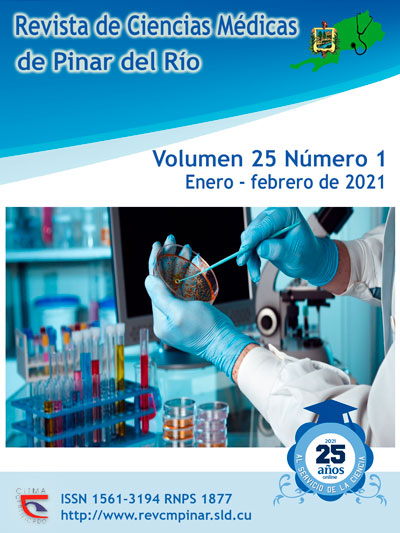GICAcovid: aplicación web para gestionar la información en Centros de Aislamiento de pacientes con COVID-2019
Keywords:
ISOLATION CENTERS, PATIENTS, COMPANIONS, INFORMATION MANAGEMENT, COVID-2019Abstract
Introduction: in the current battle that Cuba faces to deal with the pandemic, numerous mathematical models and computer applications have been developed. These analysis instruments depend on the necessary parameters to estimate from the data generated to obtain real-time information regarding the behavior of the disease from the local settings for the behavior of the disease and the implementation of editions.
Objective: to develop a web application to manage the information in the Isolation Centers for COVID-19 patients in Pinar del Río province.
Methods: technological development research, to create the processes of analysis, design and implementation of a web application of the information generated from the isolation centers for pandemic care. The scientific methods used during the development of the research are described and the technologies used to build the application are defined.
Results: GICA-Covid was created, a web application for the management of all the information collected in the isolation centers opened in the province to fight Coronavirus. This web-application registers the data of patients and their companions; the isolation centers themselves according to their type, it also generates reports and creates graphs that improve the statistics that follow the behavior of the disease in Vueltabajo region.
Conclusions: the development of the web application called GICA-covid favors a rapid management for the clinical and epidemiological study of the situation of the disease in the isolation centers of Pinar del Río province and timely decision-making.
Downloads
References
1. Huang C, Wang Y, Li X, et al. Clinical features of patients infected with 2019 novel coronavirus in Wuhan, China. Lancet [Internet]. 2020 [Citado 20/05/2020]; 395(10223):497-506. Disponible en: https://www.thelancet.com/journals/lancet/article/PIIS0140-6736(20)30183-5/fulltext
2. Lu R, Zhao X, Li J, et al. Genomic characterization and epidemiology of 2019 novel coronavirus: implications for virus origins and receptor binding. Lancet [Internet]. 2020 [Citado 20/05/2020]; 395(10224):565-574. Disponible en: https://www.thelancet.com/article/S0140-6736(20)30251-8/fulltext
3. Zhu N, Zhang D, Wang W, et al. A novel coronavirus from patients with pneumonia in China, 2019. N Engl J Med [Internet]. 2020 [Citado 20/05/2020]; 382: 727-733. Disponible en: https://www.nejm.org/doi/full/10.1056/nejmoa2001017
4. Guzmán-Del Giudice O, Lucchesi-Vásquez E, Trelles-De Belaúnde M, Pinedo-Gonzales R, Camere-Torrealva M , Daly A y Pichilingue-Chagray J. Características clínicas y epidemiológicas de 25 casos de COVID-19 atendidos en la Clínica Delgado de Lima. Revista De La Sociedad Peruana De Medicina Interna [Internet]. 2020 [Citado 20/05/2020]; 33(1):15-24. Disponible en: https://doi.org/10.36393/spmi.v33i1.506
5. OMS Informe de situación COVID-19, n.7 (11/05/2020). 2020. Disponible en: https://iris.paho.org/handle/10665.2/52425
6. Holshue ML, DeBolt C, Lindquist S, Lofy KH, Wiesman J, Bruce H, et al. First Case of 2019 Novel Coronavirus in the United States. N Engl J Med [Internet]. 2020 [Citado 20/05/2020]; 382(10):929-36. Disponible en: https://www.nejm.org/doi/full/10.1056/NEJMoa2001191
7. ACN. Cronología sobre la COVID-19 en Cuba [Internet]. 2020 [citado 30/04/2020]. Disponible en: http://www.acn.cu/cuba/63214-cronologia-sobre-la-covid-19-en-cuba-dossier
8. Zou L, Ruan F, Huang M, Liang L, Huang H, Hong Z, et al. SARS-CoV-2 Viral Load in Upper Respiratory Specimens of Infected Patients. N Engl J Med [Internet]. 2020 [Citado 20/05/2020]; 382(12):1177-9. Disponible en: https://www.nejm.org/doi/full/10.1056/nejmc2001737
9. CUBADEBATE. COVID-19: Cuba entró en fase de transmisión autóctona limitada; 2020. Disponible en: http://www.cubadebate.cu/noticias/2020/04/07/cuba-en-fase-detransmision-autoctona-limitada/#.XqxBqM3NtXw
10. Infomed. Infecciones por coronavirus. COVID-19. Temas de Salud. Infomed. 2020 [citado 05/05/2020]. Disponible en: https://temas.sld.cu/coronavirus/covid-19/
11. MINSAP. Coronavirus en Cuba. Ministerio de Salud Pública de la República de Cuba. 2020 [citado 05/05/2020]. Disponible en: https://salud.msp.gob.cu/?p=5100
12. Guzman MG. Dengue. La Habana: Editorial Ciencias Médicas. 2016 [citado 05/05/2020]:512 p. Disponible en: http://www.bvs.sld.cu/libros/dengue/dengue_completo.pdf
13. MINSAP y OPS/OMS. Neuropatía epidémica en Cuba. 1992-1994. La Habana: Editorial de Ciencias Médicas; 1995.
14. Más Bermejo P, Vidal Ledo MJ, Baldoquín Rodríguez W, Seuc Jo AH, Guinovart Díaz R, Noriega Bravo V, Pérez Rodríguez N, et al. Organización de la investigación epidemiológica para la lucha antiepidémica contra la COVID-19 en Cuba. INFODIR [Internet]. 2020 [citado 16/02/2021];(32):[aprox. 0 p.]. Disponible en: http://revinfodir.sld.cu/index.php/infodir/article/view/831
15. Gavilondo Mariño X, Vialart Vidal MN. Salud Móvil: retos y perspectivas de aplicación en Cuba. Rev Cubana Enferm [Internet]. 2016 [Citado 06/05/2020]; 32(1): [aprox. 13p.]. Disponible en: http://revenfermeria.sld.cu/index.php/enf/article/view/657
Downloads
Published
How to Cite
Issue
Section
License
Authors who have publications with this journal agree to the following terms: Authors will retain their copyrights and grant the journal the right of first publication of their work, which will be publication of their work, which will be simultaneously subject to the Creative Commons Attribution License (CC-BY-NC 4.0) that allows third parties to share the work as long as its author and first publication in this journal are indicated.
Authors may adopt other non-exclusive license agreements for distribution of the published version of the work (e.g.: deposit it in an institutional telematic archive or publish it in a volume). Likewise, and according to the recommendations of the Medical Sciences Editorial (ECIMED), authors must declare in each article their contribution according to the CRediT taxonomy (contributor roles). This taxonomy includes 14 roles, which can be used to represent the tasks typically performed by contributors in scientific academic production. It should be consulted in monograph) whenever initial publication in this journal is indicated. Authors are allowed and encouraged to disseminate their work through the Internet (e.g., in institutional telematic archives or on their web page) before and during the submission process, which may produce interesting exchanges and increase citations of the published work. (See The effect of open access). https://casrai.org/credit/



